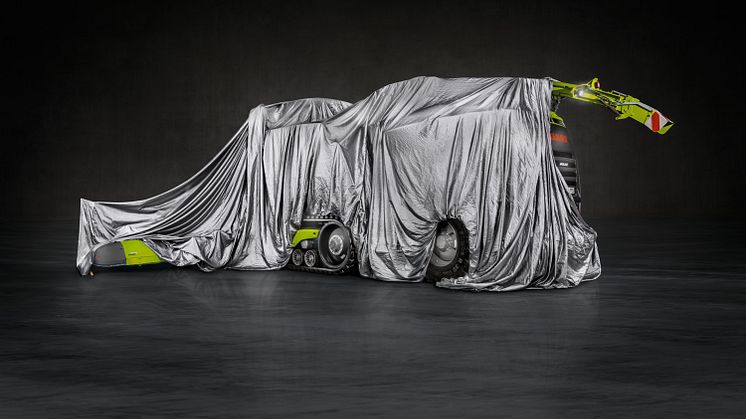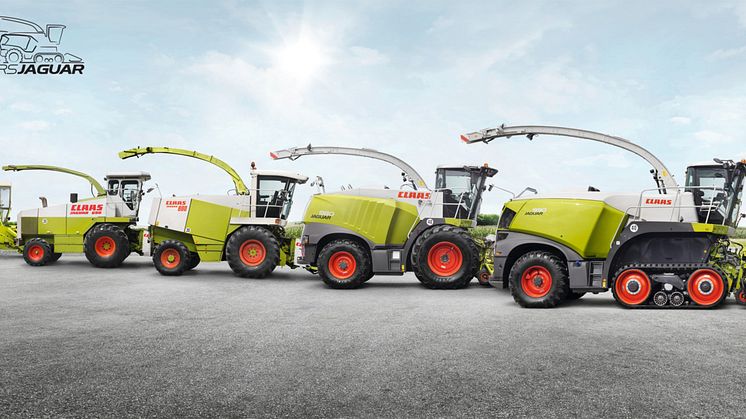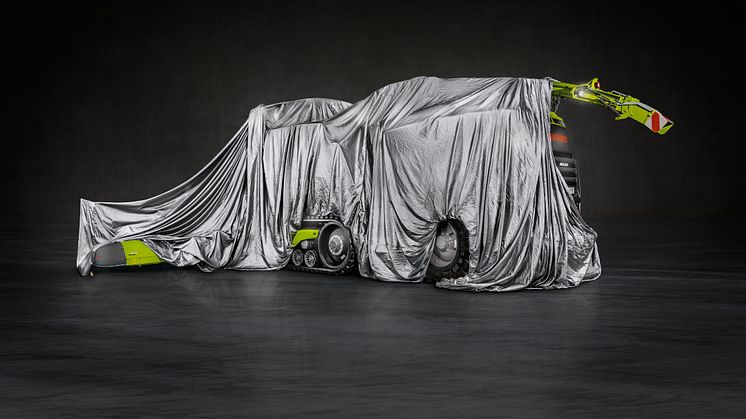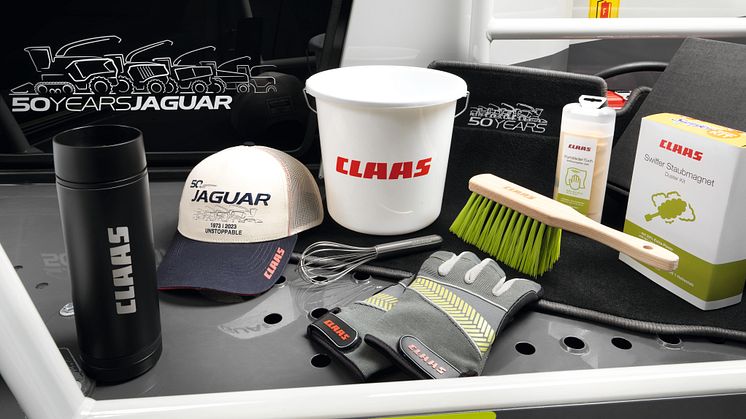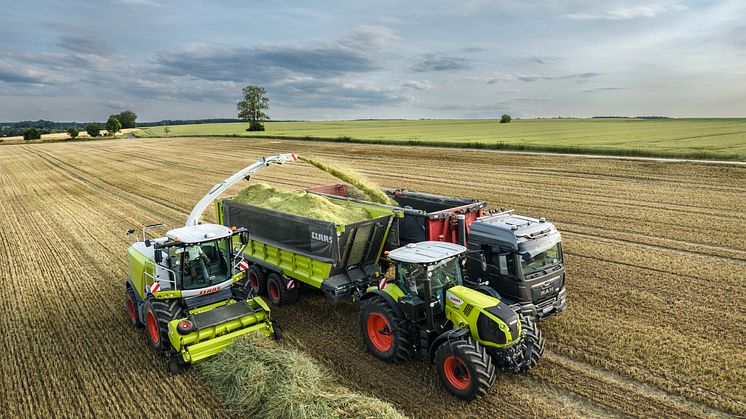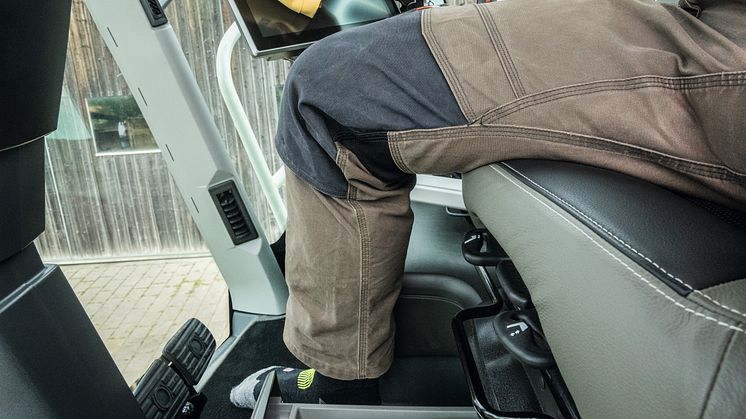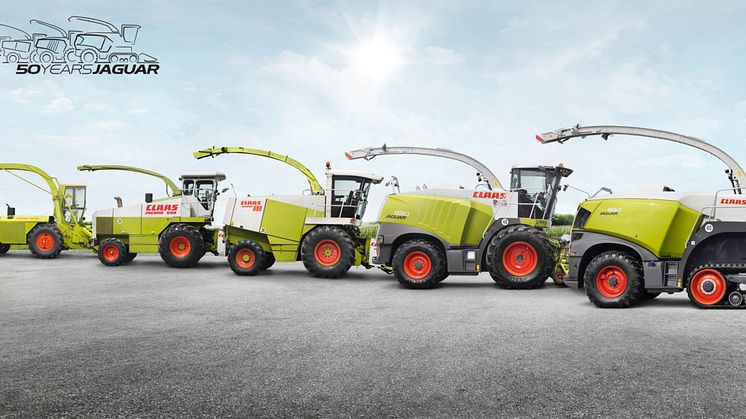
Pressemeddelelse -
Unstoppable: 50 years of JAGUAR self-propelled forage harvesters from CLAAS
CLAAS laid the foundation for an unprecedented success story in the self-propelled forage harvester segment when it launched the JAGUAR 60 SF in 1973. Featuring many innovations and durable, efficient technology, the JAGUAR very soon attained not only a worldwide reputation but also world market leadership. Today, the JAGUAR remains the number 1 choice for farmers and contractors around the world thanks to its outstanding kernel processing technology, its drive systems that protect the soil, and its extremely low full-cost profile.
Like a tractor and a combine harvester, the self-propelled forage harvester is today a key machine for many farmers and contractors, and indeed for the agricultural sector as a whole. It guarantees ideal chop length and kernel processing as well as top performance and versatility – whether it is a matter of harvesting high-quality forage for milk production and finishing bulls or harvesting biomass. CLAAS, the world market leader, can now look back on half a century of JAGUAR self-propelled forage harvesters with more than 45,000 units manufactured. "For 50 years, the JAGUAR has stood for innovation, efficiency, productivity and reliability and is surely second to none in terms of the mark it has made on the forage harvester segment throughout these five decades", says Dominik Grothe, Senior Vice President Self-Propelled Harvesters. "But CLAAS does not just owe its position as world market leader to technological advances and, by extension, to the developers and the feedback from our customers. Much of the credit must also go to our distributors and service partners because the forage harvester is a key machine, especially for contractors, and short downtime aided not only by reliable technology but also by a highly efficient parts supply system and fast, professional service is a decisive factor."
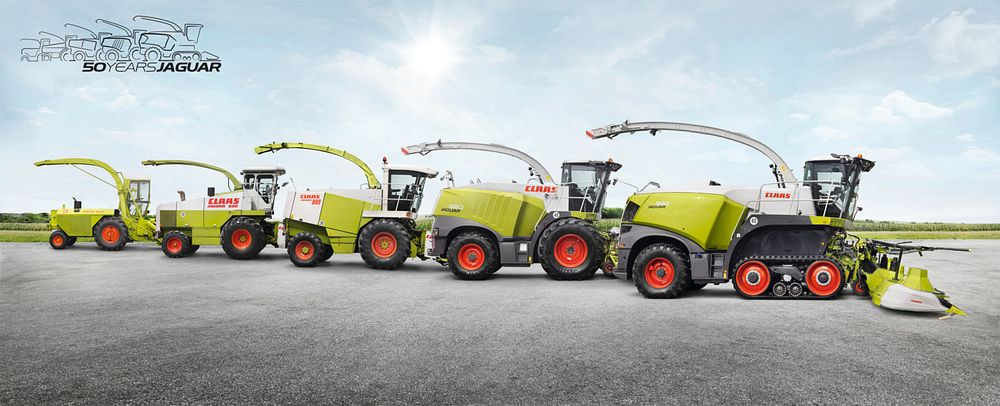
1973 – 2023: 50 years of the CLAAS JAGUAR – this period has seen more than 45,000 self-propelled JAGUAR forage harvesters leave the factory in Harsewinkel.
The leader for a low full-cost profile and product lifecycle management
Technological progress and optimum efficiency are not the only factors that have enabled the JAGUAR to defend its top position to this day. High-quality components with low wear costs, the first-class service provided by CLAAS distributors and the fast availability of parts also play a significant role. These are factors which customers can count on whether purchasing new or used machines. Within the CLAAS global sales network, used JAGUAR machines cross national borders – and even oceans – to chop elephant grass or sugar cane straw in Thailand and lavender in the South of France. This is why no other forage harvester remains in use as long as a JAGUAR. And it is also why a used JAGUAR never has to wait long for a new owner.
Getting started – with the help of combine harvester technology
Starting in the 1970s, the increasing cultivation of maize and the trend towards self-propelled machines brought about a gradual changeover from trailed to self-propelled forage harvesters, a development which occured almost simultaneously in North America, Europe and also in the then Eastern Bloc. CLAAS entered this highly promising growth segment in 1973 with the JAGUAR 60 SF after two distributors had previously produced the first prototypes on their own initiative. Sales of the 120 hp model, whose development drew on key assemblies from the trailed JAGUAR 60 drum forager and the combine harvester models of the time, ran to 33 units in the first year and grew to 500 machines by the time production ended in 1976.
It soon became clear that contractors in particular wanted an even more powerful machine. The response come in 1975 in the form of the JAGUAR 80 SF. Developed at the CLAAS facility in Bad Saulgau, the new machine had an output of 213 hp, three to four-row maize headers, a discharge blower and the new CLAAS automatic steering system. Also new was the ability to separate the feeder housing and chopping cylinder housing, which made maintenance tasks a great deal easier. At the same time, CLAAS was already developing the successor to the JAGUAR 60 SF. The JAGUAR 70 SF, had a larger chopping cylinder and a choice of a 150 or 175 hp engine. It was launched for the 1976/77 season and could harvest maize with a sustained throughput of 75 t per hour.
A trendsetter becomes the world market leader
A decade on from the launch of the JAGUAR 60 SF, 1983 saw a giant leap in technology in the form of the new JAGUAR 600 model series which set new standards for performance and chopping quality as well as design. The principal new features were the metal detector, the corncracker and the crop accelerator. State-of-the-art Mercedes-Benz engines promised high torque with low fuel consumption. The impressive new cab, adopted from the DOMINATOR combine harvesters and mounted on silent blocks, ensured excellent ergonomics and sound insulation. A new control lever enabled multiple functions to be controlled without the operator needing to reposition their right hand. The engine output of up to 300 hp meant that it was now possible to use maize headers as wide as 6 rows, a development that resulted in a further significant increase in machine efficiency. A new multiple-knife chopping cylinder with knives arranged in an offset "V" pattern was available for harvesting whole crop silage or ground ear maize. In 1988, further updates to the model series included a new cab. The JAGUAR 695 MEGA with its output of 354 hp also made its debut as the new flagship model of the successful series.
The introduction of the all-new JAGUAR 800 model series in 1994 was a sensational development that took CLAAS into a new dimension of performance and underlined its claim to technological leadership – the brand that had been European market leader with the JAGUAR 600 was now the world market leader for self-propelled forage harvesters. Furthermore, with its 481 hp, the JAGUAR 880 was also the world's most powerful forage harvester at the time. As a result, 8 rows of maize could now be harvested with a single header for the first time. One year later, the RU 450 joined the product portfolio as the first row-independent CLAAS maize header with a working width of 4.5 m. By fitting the engine transversely behind the rear axle, it could directly transmit power to the chopping cylinder using a powerband. It also acted as a counterweight to the wide front attachments. When changing from maize to grass harvesting, the corncracker could be rolled out of position quickly and easily – and vice versa, as required. A powerful crop accelerator ensured a long and accurate discharge to trucks and trailers – and even over the top of the vehicle to which the trailer is hitched. The new cab, with its curved windscreen and instructor's seat set a new standard, especially for all-round visibility and spaciousness. From 1997, a few units were built as FIELD SHUTTLE models in small series production – the majority with a sideways or rearward tipping container but a few units had a trailed dolly able to accept a semitrailer.
In 2001, the JAGUAR 900 become the first model to break the 600 hp "sound barrier". Once again; the new cab with its digital terminal and modern multifunction control lever was ahead of the competition. On top of this, from 2003 the JAGUAR SPEEDSTAR, in addition to taking maximum power output to a new high of 623hp, also become the first forage harvester to be approved for travel at 40 km/h on the road.
Efficiency through intelligence
2008 brought the next quantum leap: the new JAGUAR 900 model series which pushed the limits of performance higher still and even featured a twin engine system capable of delivering up to 830 hp in the 980 model. The new-design V-MAX chopping cylinder with its paddle-type knives was a highlight on account of its chopping quality, efficiency and clear benefits with regard to maintenance. A new generation of cab provided greater operator comfort and convenience – as did the optional AUTO FILL automatic camera and control system. In addition of these advantages, the 900 series scored highly with its intelligent DYNAMIC POWER engine control system which adjusted the engine power curve to the task in hand and provided fuel savings of up to 10 percent when operating at partial load. From 2012, the availability of an optional NIR sensor enabled continuous measurement of the dry matter content and other constituents in addition to accurate area-specific yield documentation – for the nutrient-flow balance, for example. A variable tyre pressure control system was also available ex factory not onl;y for the drive axle, but also for the steering axle which was a unique feature in the forage harvester segment, which optimised soil protection and enhanced driving comfort. In 2014, many of these features were also to be found in the new JAGUAR 800 model series.
In 2015, CLAAS acquires the SHREDLAGE® chopped maize processing technology which was developed in the USA, and has offered the MCC (MULTI CROP CRACKER) SHREDLAGE® to complement the successful and exceptionally versatile JAGUAR corncracker system ever since. Further optimisation of the crop flow and chassis of the JAGUAR 900 in 2017 was followed by a new generation of ORBIS maize headers in 2019. Two years later, CEMOS automatic functions made their debut in the JAGUAR 900 which brought further enhancements to the performance and efficiency of the "big" forage harvester series from Harsewinkel. Two forage harvesters with crawler tracks were also added to the CLAAS range in the form of the JAGUAR 960 and 990 TERRA TRAC, whose unique headland protection system enables them to be used for both maize and grassland harvesting. As well as protecting the soil, this system sets new standards for front attachment guidance.
Special model at Agritechnica and events hosted by selected distributors
At Agritechnica 2023, CLAAS will be recognising 50 years of the JAGUAR with the launch of a special edition model featuring the anniversary graphics as well as an "operator package". The centrepiece of the celebration will be the unveiling on the CLAAS stand at Agritechnica (Hall 13) of a special edition JAGUAR 990 TERRA TRAC with an exclusive anniversary colour scheme. This machine will be appearing at demonstrations during the 2024 harvest and at JAGUAR anniversary events hosted by selected distributors.
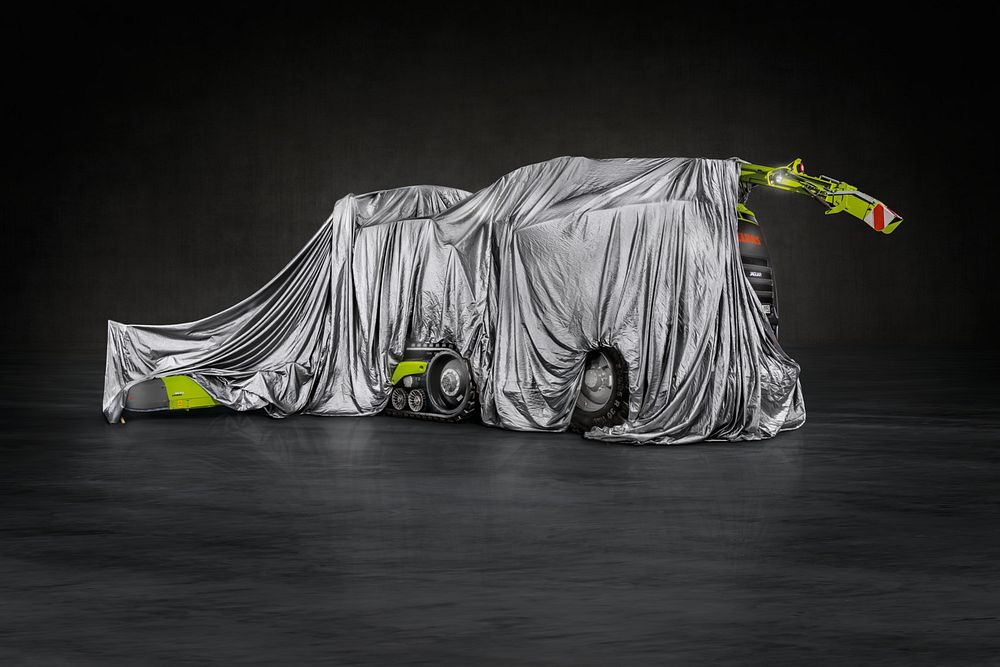
The limited edition with special paintwork will have its premiere as the JAGUAR 990 TERRA TRAC at Agritechnica – at the CLAAS booth in hall 13.
The evolution of the CLAAS JAGUAR at a glance:
- 1973: Launch of the JAGUAR 60 SF.
- 1975: Developed by CLAAS in Bad Saulgau, the JAGUAR 80 SF takes forage harvesters into a new dimension of performance with its 213 hp from a V10 diesel engine.
- 1977: CLAAS launches the JAGUAR 70 SF as the successor to the JAGUAR 60 SF.
- 1983: The all-new JAGUAR 600 generation sets new standards for self-propelled forage harvesters.
- 1989: JAGUAR 600 S/SL/MEGA with a new cab, up to 354 hp and even higher overall performance.
- 1994: JAGUAR 800 with transverse engines, up to 481 hp and an 8-row maize header for the first time. The same year sees the 10,000th JAGUAR built – and the start of the tradition of special paint finishes to celebrate JAGUAR production landmarks.
- 1997: The JAGUAR FIELD SHUTTLE combines the forage harvester with a discharge container.
- 1998: CLAAS builds the 15,000th JAGUAR featuring a sensational airbrush artwork.
- 2001: Model change and a new flagship in the form of the JAGUAR 900 with 605 hp.
- 2003: JAGUAR SPEEDSTAR approved for 40 km/h road travel.
- 2004: Production of the 20,000th JAGUAR.
- 2006: Launch of the JAGUAR 900 GREEN EYE with up to 623 hp.
- 2008: Launch of the all-new JAGUAR 900 model series with DYNAMIC POWER and many automatic functions.
- 2009: The 25,000th JAGUAR is a JAGUAR 980 with twin engine and 830 hp.
- 2011: CLAAS builds the 30,000 JAGUAR with a special black paint finish.
- 2012: Integrated NIR sensor system allows precise dry matter yield measurement and measures other constituents, such as crude ash, crude fibre and sugar precisely for each area harvested.
- 2014: Update of the JAGUAR 800 series with greater comfort, greater efficiency and greater performance.
- 2017: The new-generation JAGUAR 900 features a continuously variable front attachment drive and a new chassis concept.
- 2019: CLAAS launches the JAGUAR 900 TERRA TRAC with innovative crawler tracks featuring a unique headland protection system and introduces CEMOS AUTO PERFORMANCE for the JAGUAR at the same time.
- 2019: The 40,000th JAGUAR forage harvester leaves the production plant in Harsewinkel.
- 2020: New ORBIS maize headers combine a working width of up to 9.00 m with a transport width of just 3.00 m and integrated transport protection: greater safety on the road and significantly reduced setup time.
2022: Launch on the JAGUAR of the new GPS PILOT CEMIS 1200 for automated steering and precision farming.
Emner
Kategorier
About CLAAS
CLAAS (www.claas-group.com) is a family business founded in 1913 and is one of the world’s leading manufacturers of agricultural machinery. The company, with corporate headquarters in Harsewinkel in Germany's Westphalia region, is the world market leader in forage harvesters. In addition, CLAAS is the European market leader in another core segment, combine harvesters. Around the world, CLAAS also holds top spots with its agricultural machinery in the tractor, baler and grassland harvesting equipment segments. The CLAAS product portfolio also includes state-of-the-art farming information technology. CLAAS employs more than 12,100 staff worldwide and posted sales of 4.9 billion euros in the 2022 financial year.


